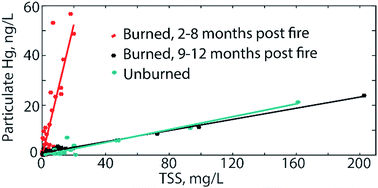当前位置:
X-MOL 学术
›
Environ. Sci.: Processes Impacts
›
论文详情
Our official English website, www.x-mol.net, welcomes your feedback! (Note: you will need to create a separate account there.)
Emerging investigator series: the effect of wildfire on streamwater mercury and organic carbon in a forested watershed in the southeastern United States†
Environmental Science: Processes & Impacts ( IF 5.5 ) Pub Date : 2017-11-03 00:00:00 , DOI: 10.1039/c7em00419b Allison M. Jensen 1, 2, 3, 4 , Todd M. Scanlon 1, 2, 3, 4 , Ami L. Riscassi 1, 2, 3, 4
Environmental Science: Processes & Impacts ( IF 5.5 ) Pub Date : 2017-11-03 00:00:00 , DOI: 10.1039/c7em00419b Allison M. Jensen 1, 2, 3, 4 , Todd M. Scanlon 1, 2, 3, 4 , Ami L. Riscassi 1, 2, 3, 4
Affiliation

|
Wildfires alter forested ecosystems, which include large stores of mercury (Hg) and organic carbon, two compounds that are closely linked in vegetation, soils, and streamwater. Studies have shown that wildfires release elevated levels of mercury to the atmosphere which can be locally redeposited and leave charred organic material (vegetation and litter) on the soil surface. Both can contribute to the elevated mobilization of Hg into lakes and streams. However, no studies have conducted a detailed examination of hydrological transport of Hg following a wildfire. This study investigates the coupled transport of mercury and carbon at Twomile Run, a headwater stream located in the forested mountains of Shenandoah National Park, in the year following a low-severity wildfire. Weekly baseflow samples and bi-hourly high-flow storm samples were analyzed for dissolved and particulate mercury (HgD and HgP, respectively), dissolved organic carbon (DOC), UV absorbance at 254 nm (UV254, surrogate for DOC quantity and character), and total suspended solids (TSS), and were compared with identical measurements taken from a nearby unburned watershed. For all flow conditions sampled at the burned site (which did not include the 2 months following the fire), streamwater HgD and DOC concentrations, and corresponding UV254, were similar to the unburned system. TSS concentrations varied between sites but overall differences were relatively small in magnitude and likely attributable to site differences rather than fire effects. Notably, the HgP per unit of TSS at the burned site was an order of magnitude higher than the unburned site (2.66 and 0.13 ng HgP per mg TSS, respectively) for 8 months following the fire, resulting in elevated HgP concentrations for the range of flow conditions, after which there was a rapid return to non-disturbed conditions. Streamwater total Hg fluxes roughly doubled (0.55 to 1.04 μg m−2 yr−1) as a consequence of the fire, indicating that in addition to changing atmospheric and terrestrial Hg cycling, fires can rapidly and significantly alter the streamwater Hg which has implication for downstream ecosystems. These findings are particularly relevant as the occurrence and severity of wildfires are expected to increase in the mid-latitudes in response to climate change.
中文翻译:

新兴研究者系列:野火对美国东南部森林流域中溪流汞和有机碳的影响†
野火改变了森林生态系统,其中包括大量的汞(Hg)和有机碳储存,这两种化合物与植被,土壤和溪流密切相关。研究表明,野火将高水平的汞释放到大气中,这些汞可以在当地重新沉积,并在土壤表面留下烧焦的有机物质(植被和垃圾)。两者都可以促进汞向湖泊和溪流中的动员。但是,没有研究对野火后汞的水文传输进行详细的研究。这项研究调查了低烈度野火发生后的一年里,在谢南多厄国家公园森林山脉上的源头水流Twomile Run处汞和碳的耦合迁移。分别为D和Hg P),溶解的有机碳(DOC),254 nm处的UV吸光度(UV 254,以DOC的数量和特征替代)和总悬浮固体(TSS),并与附近的相同测量值进行了比较未燃烧的分水岭。对于在燃烧地点采样的所有流量条件(不包括火灾后的两个月),溪流水中的Hg D和DOC浓度以及相应的UV 254与未燃烧系统相似。TSS浓度在地点之间有所不同,但总体差异幅度较小,很可能归因于地点差异而不是火灾效应。值得注意的是,汞P着火后8个月,燃烧部位每单位TSS的含量比未燃烧部位高出一个数量级(分别为每毫克TSS 2.66和0.13 ng Hg P),导致在流动条件范围内,Hg P浓度升高,此后迅速恢复到不受干扰的状态。溪水总Hg通量大约翻了一番(0.55至1.04μgm -2 yr -1)是火灾的结果,这表明除了改变大气和陆地汞的循环之外,火灾还可以迅速且显着地改变对下游生态系统有影响的溪流中的Hg。这些发现特别相关,因为预计中纬度地区的野火的发生和严重程度会因气候变化而增加。
更新日期:2017-11-03
中文翻译:

新兴研究者系列:野火对美国东南部森林流域中溪流汞和有机碳的影响†
野火改变了森林生态系统,其中包括大量的汞(Hg)和有机碳储存,这两种化合物与植被,土壤和溪流密切相关。研究表明,野火将高水平的汞释放到大气中,这些汞可以在当地重新沉积,并在土壤表面留下烧焦的有机物质(植被和垃圾)。两者都可以促进汞向湖泊和溪流中的动员。但是,没有研究对野火后汞的水文传输进行详细的研究。这项研究调查了低烈度野火发生后的一年里,在谢南多厄国家公园森林山脉上的源头水流Twomile Run处汞和碳的耦合迁移。分别为D和Hg P),溶解的有机碳(DOC),254 nm处的UV吸光度(UV 254,以DOC的数量和特征替代)和总悬浮固体(TSS),并与附近的相同测量值进行了比较未燃烧的分水岭。对于在燃烧地点采样的所有流量条件(不包括火灾后的两个月),溪流水中的Hg D和DOC浓度以及相应的UV 254与未燃烧系统相似。TSS浓度在地点之间有所不同,但总体差异幅度较小,很可能归因于地点差异而不是火灾效应。值得注意的是,汞P着火后8个月,燃烧部位每单位TSS的含量比未燃烧部位高出一个数量级(分别为每毫克TSS 2.66和0.13 ng Hg P),导致在流动条件范围内,Hg P浓度升高,此后迅速恢复到不受干扰的状态。溪水总Hg通量大约翻了一番(0.55至1.04μgm -2 yr -1)是火灾的结果,这表明除了改变大气和陆地汞的循环之外,火灾还可以迅速且显着地改变对下游生态系统有影响的溪流中的Hg。这些发现特别相关,因为预计中纬度地区的野火的发生和严重程度会因气候变化而增加。


























 京公网安备 11010802027423号
京公网安备 11010802027423号